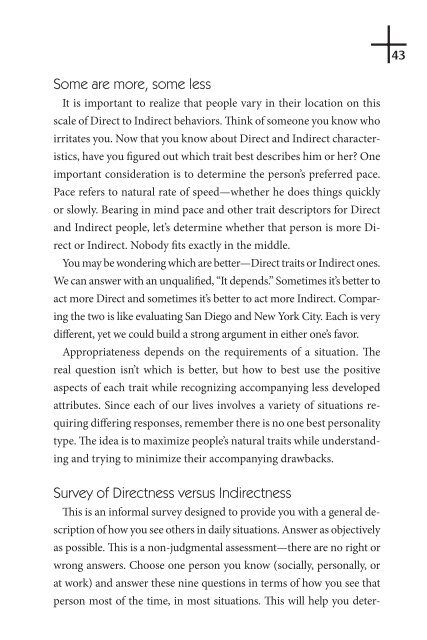PeopleSmart in Business eBook - The Platinum Rule
PeopleSmart in Business eBook - The Platinum Rule
PeopleSmart in Business eBook - The Platinum Rule
Create successful ePaper yourself
Turn your PDF publications into a flip-book with our unique Google optimized e-Paper software.
Some are more, some less<br />
It is important to realize that people vary <strong>in</strong> their location on this<br />
scale of Direct to Indirect behaviors. Th <strong>in</strong>k of someone you know who<br />
irritates you. Now that you know about Direct and Indirect characteristics,<br />
have you fi gured out which trait best describes him or her? One<br />
important consideration is to determ<strong>in</strong>e the person’s preferred pace.<br />
Pace refers to natural rate of speed—whether he does th<strong>in</strong>gs quickly<br />
or slowly. Bear<strong>in</strong>g <strong>in</strong> m<strong>in</strong>d pace and other trait descriptors for Direct<br />
and Indirect people, let’s determ<strong>in</strong>e whether that person is more Direct<br />
or Indirect. Nobody fi ts exactly <strong>in</strong> the middle.<br />
You may be wonder<strong>in</strong>g which are better—Direct traits or Indirect ones.<br />
We can answer with an unqualifi ed, “It depends.” Sometimes it’s better to<br />
act more Direct and sometimes it’s better to act more Indirect. Compar<strong>in</strong>g<br />
the two is like evaluat<strong>in</strong>g San Diego and New York City. Each is very<br />
diff erent, yet we could build a strong argument <strong>in</strong> either one’s favor.<br />
Appropriateness depends on the requirements of a situation. Th e<br />
real question isn’t which is better, but how to best use the positive<br />
aspects of each trait while recogniz<strong>in</strong>g accompany<strong>in</strong>g less developed<br />
attributes. S<strong>in</strong>ce each of our lives <strong>in</strong>volves a variety of situations requir<strong>in</strong>g<br />
diff er<strong>in</strong>g responses, remember there is no one best personality<br />
type. Th e idea is to maximize people’s natural traits while understand<strong>in</strong>g<br />
and try<strong>in</strong>g to m<strong>in</strong>imize their accompany<strong>in</strong>g drawbacks.<br />
Survey of Directness versus Indirectness<br />
Th is is an <strong>in</strong>formal survey designed to provide you with a general description<br />
of how you see others <strong>in</strong> daily situations. Answer as objectively<br />
as possible. Th is is a non-judgmental assessment—there are no right or<br />
wrong answers. Choose one person you know (socially, personally, or<br />
at work) and answer these n<strong>in</strong>e questions <strong>in</strong> terms of how you see that<br />
person most of the time, <strong>in</strong> most situations. Th is will help you deter-<br />
43


